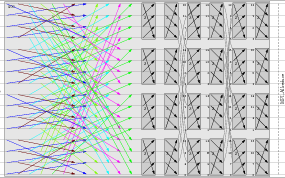Section: New Results
Modeling the behavior of parallel traces
Participants : Alain Ketterlin, Stéphane Genaud.
We have started this year a project aiming at developing algorithms and tools to capture the behavior of parallel programs. Our initial goal is automatically obtain formal models of communicating MPI processes, in terms of message sends and receives and of synchronization events. Such models have various uses, the first of them being the visualization of the system's communications, for debugging, or plain understanding (see below, Figure 4 ). However, we expect to develop other applications, for example in optimizing the communication infrastructure (or routing algorithm) for specific applications.
Our modeling algorithm works in two phases. The first phase is local to each node, using our work on nested loop recognition [7] . This builds a sequence of loop nests providing a compact representation of all local communication events. At the end of the run, the various local models are merged, typically through a parallel reduction operation, to build the global model.
We plan to publish the first part of this work in the first half of 2013. Several experimental data have been collected already, but we would like to evaluate the overall task on significantly sized programs.
Currently, the whole process is restricted to communication events. However, it can be immediately extended to trace including other kinds of events, like the addresses and sizes of memory buffers transmitted from process to process. This would provide a complete, run time description of the program, which could be used to evaluate the potential gain of various re-parallelization techniques. This aspect is the next goal on our agenda.



